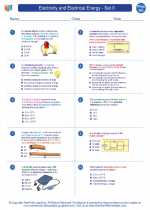Electricity and Electrical Energy - Set II
1. What is Ohm's law?
Ohm's law states that the current flowing through a conductor between two points is directly proportional to the voltage across the two points, given a constant temperature.
2. Define electric power and its units.
Electric power is the rate at which electrical energy is transferred by an electric circuit. It is defined as P = IV, where P is power, I is current, and V is voltage. The unit of electric power is the watt (W).
3. Explain the difference between series and parallel circuits.
In a series circuit, the components are connected end-to-end, so that the current flows through each component in the same path. In a parallel circuit, the components are connected across common points, allowing the current to split and flow through each component on different paths.
4. What is electrical resistance?
Electrical resistance is a measure of the opposition to the flow of an electric current in a material. It is denoted by the symbol R and is measured in ohms (Ω).
5. Describe the concept of electrical energy and its calculation.
Electrical energy is the energy that is carried by an electric current. It is calculated using the formula E = P * t, where E is energy, P is power, and t is time.
6. Explain the role of conductors and insulators in electrical circuits.
Conductors are materials that allow electric current to flow through them easily, while insulators are materials that do not allow electric current to flow through them. Conductors are used to carry electrical energy, while insulators are used to prevent the flow of electricity.
7. Discuss the safety measures to be taken while working with electrical circuits.
- Always disconnect the power source before working on a circuit. - Use insulation materials to cover exposed wires. - Avoid working on electrical circuits in wet or damp conditions. - Do not overload electrical circuits with too many devices.
8. What are the applications of electrical energy in everyday life?
Electrical energy is used in various everyday applications such as lighting, heating, cooling, cooking, powering electronic devices, transportation, and communication.
.◂Physics Worksheets and Study Guides High School. Electricity and Electrical Energy - Set II

 Worksheet/Answer key
Worksheet/Answer key
 Worksheet/Answer key
Worksheet/Answer key
